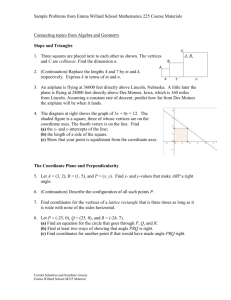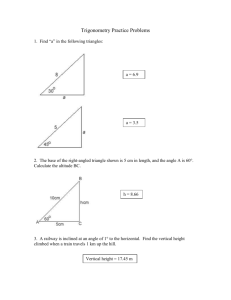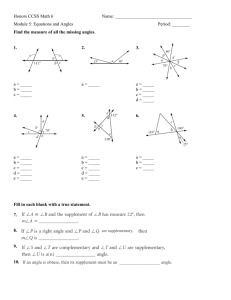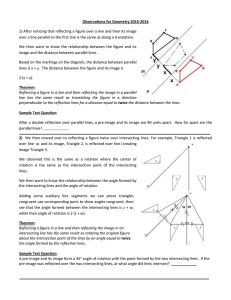Activity 1.5.2 Composition – Two Reflections II
advertisement
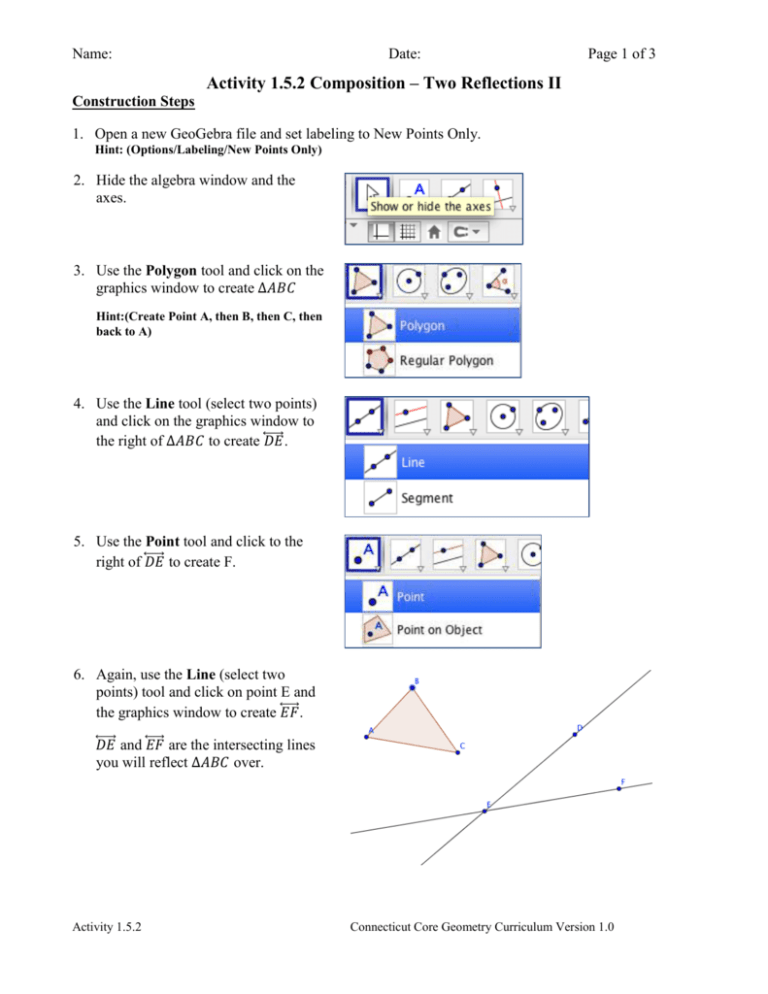
Name: Date: Page 1 of 3 Activity 1.5.2 Composition – Two Reflections II Construction Steps 1. Open a new GeoGebra file and set labeling to New Points Only. Hint: (Options/Labeling/New Points Only) 2. Hide the algebra window and the axes. 3. Use the Polygon tool and click on the graphics window to create ∆𝐴𝐵𝐶 Hint:(Create Point A, then B, then C, then back to A) 4. Use the Line tool (select two points) and click on the graphics window to the right of ∆𝐴𝐵𝐶 to create ⃡𝐷𝐸 . 5. Use the Point tool and click to the right of ⃡𝐷𝐸 to create F. 6. Again, use the Line (select two points) tool and click on point E and the graphics window to create ⃡𝐸𝐹 . ⃡𝐷𝐸 and ⃡𝐸𝐹 are the intersecting lines you will reflect ∆𝐴𝐵𝐶 over. Activity 1.5.2 Connecticut Core Geometry Curriculum Version 1.0 Name: Date: Page 2 of 3 7. Use the Reflect about Line tool and click on ∆𝐴𝐵𝐶 and ⃡𝐷𝐸 to create ∆𝐴′𝐵′𝐶′. 8. Use the Reflect about Line about line tool and click on ∆𝐴′𝐵′𝐶′ and ⃡𝐸𝐹 to create ∆𝐴′′𝐵′′𝐶′′. Exploration Steps and Comprehension Questions In the previous activity you found that reflecting a figure over intersecting lines yields the same result as a rotation about the intersection point. Using GeoGebra you will experiment rotating ∆𝐴𝐵𝐶 to understand this concept in more depth. a. Using the Segment tool, connect point E to a pair of corresponding vertices on the original figure (∆𝐴𝐵𝐶) and the final image (∆𝐴′′𝐵′′𝐶′′). b. Using the Angle tool, measure and record the following: the acute angle formed by connecting point E to a pair of corresponding vertices from the pre-image and final image the acute angle ∠𝐷𝐸𝐹 formed by the intersecting reflection lines ⃡𝐷𝐸 and ⃡𝐸𝐹 . (An example of a possible scenario is shown below) Record Angle Measurements Here: a. Measure of angle formed by vertices pre-image and the final image: ____________ b. Measure of angle formed by intersecting lines: ____________ Activity 1.5.2 Connecticut Core Geometry Curriculum Version 1.0 Name: Date: Page 3 of 3 c. What do you notice about the measure of the angle formed by the intersecting reflection lines ⃡𝐷𝐸 and ⃡𝐸𝐹 and the angle formed by connecting point E pair of corresponding vertices from the preimage and the final image (the angle measured in part b). d. Using the Rotate around Point tool, rotate ∆𝐴𝐵𝐶 clockwise about point E (intersection point of ⃡𝐷𝐸 and ⃡𝐸𝐹 )) by the degree equal to the angle formed by connecting point E pair of corresponding vertices from the pre-image and the final image (the angle measured in part b). e. Comment on any relationship you observe between: The location of ∆𝐴𝐵𝐶 rotated about point E (the intersection of reflection lines ⃡𝐷𝐸 and ⃡𝐸𝐹 ) by the degree equal to the angle formed by connecting point E pair of corresponding vertices from the pre-image and the final image (the angle measured in part b). AND The location of ∆𝐴𝐵𝐶 as a result of reflecting it over intersecting lines ⃡𝐷𝐸 and ⃡𝐸𝐹 f. What do you notice about the measure of the angle formed by the intersecting reflection lines ⃡𝐷𝐸 and ⃡𝐸𝐹 and the rotation that maps ∆𝐴𝐵𝐶 directly onto ∆𝐴′′𝐵′′𝐶′′. Activity 1.5.2 Connecticut Core Geometry Curriculum Version 1.0

